First written 23 March 1983, Panama City, Panama
By: LT. Gwen F. Hall, USN (ITF 4th Dan) © UPDATED MAY, 2011
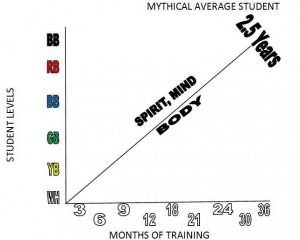
The term “average Tae Kwon Do student” implies that the physical, mental and spiritual elements are equally contained in a student and equally develop simultaneously in the ideal time frame of 2.5 years. I maintain that such a situation is a myth. There is no “average” Tae Kwon Do student. There are just students, all with varying qualities, elements, and abilities.
During approximately 20 (now over 50 years) years of martial arts experience, I have observed what I term “7 Basic Profiles” of beginning students with an occasional student falling between profiles. The elements in a profile are the spiritual, mental and physical attributes of the student. Each profile necessitates particular training approaches emphasizing the development of one or more of the elements at different times to align their proficiency levels to produce the desired profile. The objective is to unite the spirit, mind and body to create a teachable 1st Dan.
The training time required for a beginning student in a profile to attain each rank level varies with the student and is affected by his progress at each level acquired. As the student progresses in training, the level of development for each element and its progress in relation to the other elements will fluctuate. Over time, the lines representing the elements growth and change may cross over one another, may run parallel for a time and ultimately all three should become united. The following graphs show what the student’s mind, body, and spirit relationship would be if he was ever placed in an environment of growth and tutelage. Tae Kwon Do training should provide that fertile environment. The challenge for the instructor is to identify each student’s profile early enough to develop that student’s maximum potential before the student is either discontinued or becomes a handicapped trainee; never acquiring unity of the three elements.
The instructor must be able to recognize the profile, work with that profile, be able to spot a student’s changing in profile and adjust the training subtleties accordingly..all in the group training environment. The “final” product of 1st Dan is a student ready to become the Art. He should be spiritually whole, ready to mature mentally and physically. Proper identity of the beginning student’s profile must be within the first month and a half of training to produce such a 1st Dan.
The following graphic representations and accompanying discourses of each profile are designed as instructor’s tools for student development. No praise or condemnation is attached to any of the profiles; knowing one’s assets and needs enables efficient progress and Art development. Praise or condemnation arises from what is done with what one has.
DECEPTIVE PRODIGY
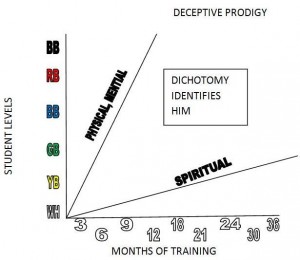 Students in the Deceptive Prodigy profile can perform basic and advanced techniques way beyond expectation and answer all technical/historical questions perfectly within the first six to seven months of training. His physical prowess may exceed his instructor’s within a year and a half. Every thing comes easy for him; yet, this student seems hollow, cold, mechanical, methodical and unreachable personally. He takes constructive criticism quietly but grudgingly, some times looking askantly at the instructor’s back from the corner of his eyes. The missing element is spiritual. There is no heart of respect, no drive to succeed, no humility, no Pil Sung. Weather missing at birth and never acquired while living or broken by events in one’s past, the lack of the spiritual element in a student causes laziness or boredom with technique/tul repetition. The result is student drop out, or worse, student self evaluation as “better than” everyone else in the school, including the instructor. Such attitude and behavior can be insidiously slow to develop or may appear full-blown within a few months.
Students in the Deceptive Prodigy profile can perform basic and advanced techniques way beyond expectation and answer all technical/historical questions perfectly within the first six to seven months of training. His physical prowess may exceed his instructor’s within a year and a half. Every thing comes easy for him; yet, this student seems hollow, cold, mechanical, methodical and unreachable personally. He takes constructive criticism quietly but grudgingly, some times looking askantly at the instructor’s back from the corner of his eyes. The missing element is spiritual. There is no heart of respect, no drive to succeed, no humility, no Pil Sung. Weather missing at birth and never acquired while living or broken by events in one’s past, the lack of the spiritual element in a student causes laziness or boredom with technique/tul repetition. The result is student drop out, or worse, student self evaluation as “better than” everyone else in the school, including the instructor. Such attitude and behavior can be insidiously slow to develop or may appear full-blown within a few months.
To verify the identity of this profile and test for a student’s spirit, the instructor may fail the student during promotions between 6 and 4th gup, continually push the physical limits to exhaustion forcing whatever spirit he possess to come forth to give him strength to last the training period, assign extra duties and responsibilities within the Dojang student support programs and seek productivity in other than Tae Kwon Do techniques and knowledge. Should the student submit to such a regimen, he might begin to develop spiritually.
The Deceptive Prodigy must learn that talent and ability decline with time unless skill and expertise are developed with time. An un-lived in rock building eventually crumbles into rubble.
Often most draining on an instructor, it is next to impossible to teach the deceptive prodigy spiritual character. Such a student needs to be shocked into seeing the need for spiritual growth and become receptive to it. He needs to realize that as youth and health fail, only Martial Art (Pil Sung) spirit will provide the strength to survive and succeed. For some, this realization is impossible to recognize and accept. They should be dis-enrolled from the school.
SILENT PILLAR
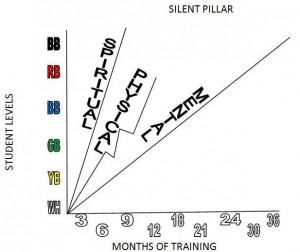
This profile is usually quite, attends faithfully, often seems physically inflexible, will answer verbal questions, but appears to have trouble learning required written material. Make no mistake about this student. He is not stupid; he is not physically deficient. His development physically depends on gaining better flexibility; his body is fine. The progress may be slow at first, but with selected exercises, encouragement and practice, he will accomplish it. Increased mental development through more formal education must be required in his training program.
This student often comes from a difficult childhood or a deprived economic and educational background. He is frequently though and streetwise, but seldom rude or cocky. Due to a lack of formal education, his mental capacity has not yet been utilized; it is there and must be developed. He needs to be required to go back to school, take night courses or enroll in an adult study program to obtain his GED or high school diploma. Like all Tae Kwon Do students, he should then be encouraged to continue formal education by taking college courses when feasible.
A student from this background has a good heart and a survivor’s spirit. He has been around, knows truth when he sees it, and makes an eager, very good Tae Kwon Do devotee. He can become the Dojang’s pillar.
NATURAL MARTIAL ARTIST
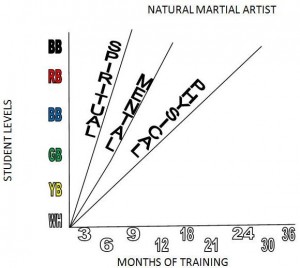
The Natural Martial Artist is seldom encountered and most instructors never have the opportunity to relate with such a person. Even though rare, an experienced instructor recognizes this profile immediately. Oblivious to the hours of practice and years of devotion that he will eventually spend, this individual trains hard and during the first week of class, commits himself and life to being the Art. He does not speak about this commitment to anyone, and even as an assistant instructor, does not verbally express a desire to open a school or be a professional instructor. Without a lot of talk, when the time is right, he simply, and quietly opens the school. His spirit is seen in his eyes and face; his physical growth, nourished by the gallons of sweat that run from his forehead, portrays the covenant. He comes early stays late..leaving only when the Dojang closes at night. He sacrifices everything to practice, often awakening in the night to perform a Tul and then returns to bed and sound sleep. He will practice in the vacant restroom lounge on a train and in the bathroom at work or school.
The Natural Martial Artist needs only guidance/coaching and a teaching/knowledge source. He is his own motivation, critic and in many respects, instructor. He will grow no matter what problems he encounters and is a mature Black Belt spiritually within six months. he is the class spiritual inspiration, without knowing it, and gladly serves as a perfect assistant instructor at any level. This student enjoys helping others and applies himself more than anyone he assists. He has an innate understanding of the Art and is a natural born instructor. His own skill develops methodically and rapidly.
It is his spirit and innate understanding of the Martial Art Way, not necessarily his physical prowess, that characterizes him. His dedication, humility and high character seem endless. His spirit and mind far outreach his body’s capacity early in training.
PHYSICALLY DISADVANTAGED
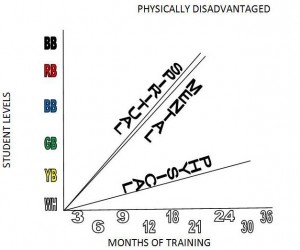
A student in this profile attends faithfully, and has desire to learn. His mental and spiritual growth is normally gained together. The physical problems may have a varied source and for all but the extermely disabled, frequently consist of frozen tendons and some degree of calcified ligament tissue, or he may be physically weak. He often tends toward awkwardness and is jerky and uncoordinated in his movements.
Special exercise should be assigned to such a student to develop his body and or flexibility. Extensive repetition of Saju Jirugi and Saju Maki must be required to improve nerve to muscle signal development and appendage movement coordination. A few minuets of self practice on these sequences during formal class time should be part of his training program. Eye to mind to muscle to movement message systems need development; constant repetition of Saju Jirugi & Saju Maki create and build this vital “body road map” sequence. The instructor must encourage this student through this slow body development.
This profile also includes students with partial or total loss of eyesight and some appendage amputees. Depending on the type and severity of disability, unique methods and approaches to instruction may be adopted. Tailored workout regimen, technique/tul modifications and a flexible instruction system can be utilized to develop the Martial Artist in these students.
Experience has proven that, except for the extreme situation, programs can generally be tailored to a specific disability and provides the opportunity to progress and grow within the limits of the disadvantage that disability causes. As long as the student is willing, success usually becomes a matter of dedication and application.
Like the cicada, the physically disadvantaged student struggles, sometimes with great pain, from his shell. As long as he continues the effort, he will live to fly. If he stops at anytime to rest too long, he dies trapped half in the shell….half out. His instructor must supply the will to survive until the student progresses far enough out of his physical disadvantage to recognize his progress and be, thereby, inspired.
THE IDEAL STUDENT
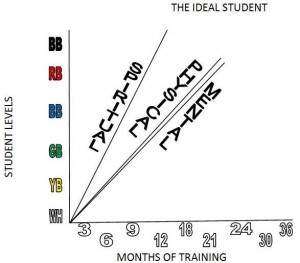
Excluding the Natural Martial Artist, the rare ideal student can enter at the Dojang door or emerge from one of the previous profiles as his problem elements improve. Instructors must always watch for the indications that a student is on the verge of such a change and bring it to fruition. Those that enter the Dojang in this profile become self starters at around 7th or 6th Gup and exhibit leadership-instructor potential. This student often motivates his fellow classmates, but needs to learn the art of being a teacher. His mind and body are a unit and grow as such. The differences between this student and the Deceptive Prodigy are his spiritual character and loyalty to high principles. The difference between him and the Natural Martial Artists is that the ideal student’s mind is tied to his body and learns or realizes knowledge as his body acquires physical technique proficiency. The ideal student smoothly emerges into a Martial Artist… attending faithfully and practicing daily, not just attending during mandatory formal training periods.
SELF ELIMINATION/UN-TRAINABLE
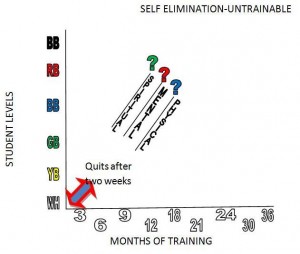
The sixth profile to be discussed depicts a sad but very real portion of mankind..the Self Eliminating, un-trainable. These persons can not be termed a “student” because they glare with self-contained, predetermined non-accomplishment. An experienced instructor recognizes them the moment they open their mouths. Entering the Dojang speaking excitedly about wanting to train as soon as possible, this category bubbles with eagerness and expounds many words about their desires. My first instructor, Mr. Sang Ki Eun, used to say, “the more they talk, the less they train.”
This group constitutes the vast majority of people who enter a school and are destined, by a flaw of personality, to normally last no longer than two weeks, a month at most. In spite of the strictest screening, (no matter how well the instructor explains the rigors of training, the sweat and hours of hard work required, and the standards of attendance,) these people are always saying “yes, yes I’ll be here, I’ve always wanted to do this,” etc. They nod their heads eagerly that they will train hard. They come a week or two and then suddenly are never seen again…no explanation, no phone call as to why. They just do not cross the school threshold anymore. In the meantime, the Dojang’s administrative procedures, instructors energy and school materials were wasted. This profile depicts the non-student who probably spends his life time beginning projects, courses and programs that he never finishes. They constitute the large number of people who generate administrative burdens and never accomplish anything. This profile is not a training tool, for those persons depicted by it are not students. A prerequisite to enrollment requiring 2 weeks observing several entire class periods usually self eliminates such applicants.
DESIRED PROFILE
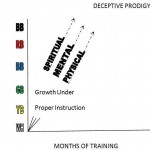
Excluding the non-student, Self Elimination profile, the other entering profiles of beginning students are just that. They illustrate the student’s spiritual, mental and physical condition at the time he begins training. The profiles are not chiseled in stone and do not reflect how each student will emerge if properly instructed. The profiles are analysis tools to develop meaningful training approaches for each student in the Dojang. Some instructors may keep each student’s profile in his mind. Others might make an actual chart in each student’s training record. Where and how a tracking system is maintained does not matter, as long as the method is productively employed.
When the student has entered the Desired Profile of 1st Dan, it means he is now ready to truly develop as a Tae Kwon Do Martial Artist. The student is usually spiritually mature as represented by the continuous line. He is ready to mature mentally and physically as represented by the dashed lines. They end at 1st Dan to indicate, not that he is finished, but that he must train further to extend the rest of his make-up to the level of his spiritual growth. The lines run parallel for graphic purposes. In reality they are united as a Martial Artist’s mind, body and spirit should be.
There are no monthly time designators to correspond with rank levels shown in this profile. They are unique, individual unknowns to be printed as each student progresses from his beginning profile. Each Tae Kwon Do student’s (Hoc Sang’s) profile graph will be continually printed with the three lines representing the three elements changing position in relation to one another until his beginning profile has evolved into the Desired Profile.
Pil Sung
GWEN HALL
![]()


Average Rating